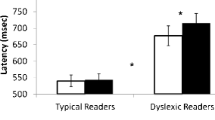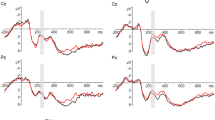Abstract
The purpose of this study was to determine whether poor readers have more pronounced problems than average-reading peers reading derived words the base forms of which undergo a phonological shift when a suffix is added (i.e., shift relations as in “natural”), as compared to derived words whose forms are phonologically and orthographically transparent (i.e., stable relations, as in “cultural”). Two computer-based word recognition tasks (Naming and Lexical Decision) were administered to children with reading disability (RD), peers with average reading ability, and adults. Across tasks, there was an effect for transparency (i.e., better performance on stable than shift words) for both child groups and the adults. For the children, a significant interaction was found between group and word type. Specifically, on the naming task, there was an advantage for the stable words, and this was most noteworthy for the children with RD. On the lexical decision task, trade-offs of speed and accuracy were evident for the child reader groups. Performances on the nonwords showed the poor readers to be comparable to the average readers in distinguishing legal and illegal nonwords; further analyses suggested that poor readers carried out deeper processing of derived words than their average reading peers. Additional study is needed to explore the relation of orthographic and phonological processing on poor readers’ memory for and processing of derived words.
Similar content being viewed by others
References
Balota, D. A. (1990). The role of meaning in word recognition. In D. A. Balota, G. B. Flores d’Arcais, & K. Rayner (eds.), Comprehension processes in reading (pp. 9–32). Hillsdale, NJ: Lawrence Erlbaum Associates.
Berninger, V. W., & Abbott, R. D. (1994). Multiple orthographic and phonological codes in literacy acquisition: An evolving research program. In V. W. Berninger (ed.), The varieties of orthographic knowledge I: Theoretical and developmental issues (pp. 277–319). Dordrecht, The Netherlands: Kluwer Academic Publishers.
Besner, D. (1999). Basic processes in reading: Mulitple routines in localist and connectionist models. In R. M. Klein, & P. McMullen (eds.), Converging methods for understanding reading and dyslexia (pp. 413–458). Cambridge, MA: MIT Press.
Carlisle, J. F. (2000). Awareness of the structure and meaning of morphologically complex words: Impact on reading. Reading and Writing, 12(3–4), 169–190.
Carlisle, J. F., & Nomanbhoy, D. (1993). Phonological and morphological development. Applied Psycholinguistics, 14, 177–195.
Carlisle, J. F., & Stone, C. A. (in press). The effects of morphological structure on children’s reading of derived words. In E. Assink & D. Santa (eds.), Reading complex words: Cross-language studies. Kluwer.
Carreker, S. (1999). Teaching reading: Accurate decoding and fluency. In J. R. Birsh (ed.), Multisensory teaching of basic language skills (pp. 141–182). Baltimore: Paul H. Brookes.
Carroll, J. B., Davies, P., & Richman, B. (1971). Word frequency book. NY: American Heritage Publishing Company.
Champion, A. H. (1997). Knowledge of suffixed words in reading and oral language contexts: A comparison of reading disabled and normal readers. Annals of Dyslexia, 47, 29–55.
Cole, P., Beauvillain, C., & Segui, J. (1989). On the representation and processing of prefixed and suffixed derived words. Journal of Memory and Language, 28, 1–13.
Compton, D. L., & Carlisle, J. F. (1994). Speed of word recognition as a distinguishing characteristic of reading disabilities. Educational Psychology Review, 6, 115–140.
Denckla, M. B., & Rudell, R. G. (1976). Naming of objects by dyslexic and other learning-disabled children. Brain and Language, 3, 1–15.
Derwing, B. B. L., Smith, M. L., & Wiebe, G. E. (1995). On the role of spelling in morpheme recognition: Experimental studies with children and adults. In L. B. Feldman (ed.), Morphological aspects of language processing (pp. 3–27). Hillsdale, NJ: Lawrence Erlbaum Associates.
Dunn, L. M., & Dunn, L. M. (1997). Peabody picture vocabulary test, 3rd edition. NY: American Guidance Service.
Ehri, L. C. (1997). Sight word learning in normal readers and dyslexics. In B. Blachman, (ed.), Foundations of reading acquisition and dyslexia (pp. 163–189). Hillsdale, NJ: Lawrence Erlbaum Associates.
Elbro, C., & Arnbak, E. (1996). The role of morpheme recognition and morphological awareness in dyslexia. Annals of Dyslexia, 46, 209–240.
Fowler, A. E., & Liberman, I. Y. (1995). The role of phonology and orthography in morphological awareness. In L. B. Feldman (ed.), Morphological aspects of language processing (pp. 157–188). Hillsdale, NJ: Lawrence Erlbaum Associates.
Fowler, C., Napps, S., & Feldman, L. B. (1985). Relations among regular and irregular morphologically related words in the lexicon as revealed by repetition priming. Memory and Cognition, 13, 241–255.
Gordon, P. (1989). Levels of affixation in the acquisition of English morphology. Journal of Memory and Language, 28, 519–530.
Henry, M. K. (1988). Beyond phonics: Integrated decoding and spelling instruction based on word origin and structure. Annals of Dyslexia, 38, 259–275.
Leong, C. K. (1989). Productive knowledge of derivational rules in poor readers. Annals of Dyslexia, 39, 94–115.
Liberman, I. Y., Shankweiler, D., & Liberman, A. M. (1989). The alphabetic principle and learning to read. In D. Shankweiler & I. Y. Liberman (eds.), Phonology and reading disability (pp. 1–34). Ann Arbor, MI: University of Michigan Press.
Lovett, M., Lacerenza, L., & Borden, S. L. (2000). Putting struggling readers on the PHAST track: A program to integrate phonological and strategy-based remedial reading instruction and maximize outcomes. Journal of Learning Disabilities, 33, 458–476.
Manis, F. R. (1985). Acquisition of word identification skills in normal and disabled readers. Journal of Educational Psychology, 77(1), 78–90.
Moats, L. (2000). Speech to print: Language essentials for teachers. Baltimore: Brookes.
Nagy, W. E., Anderson, R., Schommer, M., Scott, J. A., & Stallman, A. C. (1989). Morphological families and word recognition. Reading Research Quarterly, 24, 262–282.
Perfetti, C. A. (1992). The representation problem in reading acquisition., In P. B. Gough, L. C. Ehri, & R. Treiman (eds.), Reading acquisition (pp. 145–174). Hillsdale, NJ: Lawrence Erlbaum Associates.
Royer, J. M., & Sinatra, G. M. (1994). A cognitive-theoretical approach to reading diagnostics. Educational Psychology Review, 6, 81–113.
Shankweiler, D., Crain, S., Katz, L., Fowler, A. E., Liberman, A. M., Brady, S. A., Thornton, R., Lundquist, E., Dreyer, L., Fletcher, J. M., Stuebing, K. K., Shaywitz, S. E., & Shaywitz, B. A. (1995). Cognitive profiles in reading disabled children: Comparison of language skills in phonology, morphology, and syntax. Psychological Science, 6(3), 149–156.
Siegel, L. S., Share, D., & Geva, E. (1995). Evidence for superior orthographic skills in dyslexics. Psychological Science, 6(4), 250–253.
Singson, M., Mahoney, D., & Mann, V. (2000). The relation between reading ability and morphological skills: Evidence from derivational suffixes. Reading and Writing: An Interdisciplinary Journal, 12, 219–252.
Stanovich, K. E. (1986). Matthew effects in reading: some consequences of individual differences in the acquisition of literacy. Reading Research Quarterly, 21, 360–406.
Stoltz, J. A., & Feldman, L. B. (1995). The role of orthographic and semantic transparency of the base morpheme in morphological processing. In L. B. Feldman (ed.), Morphological aspects of language processing (pp. 109–129). Hillsdale, NJ: Lawrence Erlbaum Associates.
Templeton, S., & Scarborough-Franks, L. (1985). The spelling’s the thing: Knowledge of derivational morphology in orthography and phonology among older students. Applied Psycholinguistics, 6, 371–390.
Wilkinson, G. (1993). Wide range achievement test, 3rd edition. Wilmington, DE: Wide Range Inc.
Windsor, J. (2000). The role of phonological opacity in reading achievement. Journal of Speech, Language, and Hearing Research, 43, 50–61.
Woodcock, R. M. (1987). Woodcock reading mastery test - revised. Circle Pines, MN: American Guidance Service.
Author information
Authors and Affiliations
Rights and permissions
About this article
Cite this article
Carlisle, J.F., Stone, C.A. & Katz, L.A. The effects of phonological transparency on reading derived words. Ann. of Dyslexia 51, 249–274 (2001). https://doi.org/10.1007/s11881-001-0013-2
Issue Date:
DOI: https://doi.org/10.1007/s11881-001-0013-2




